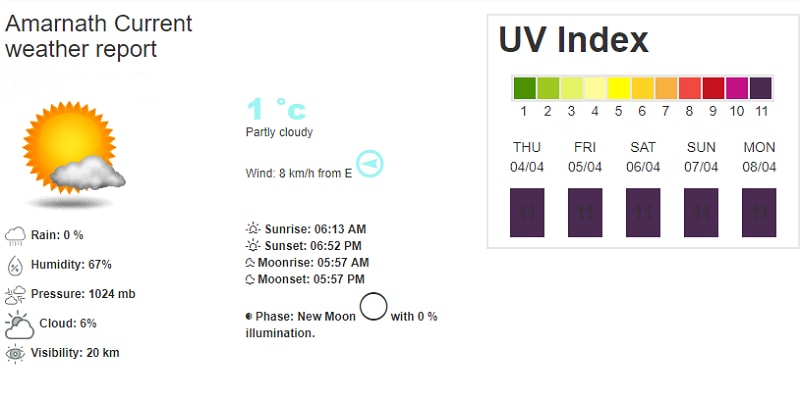The climatic conditions of this pilgrimage are quite inconsistent. There is a huge possibility of rainfall and even snowfall anytime and anywhere. It is also believed that the sunny weather soon turns out in cold climate after a short rainfall. May to September is the most ideal time to plan your Amarnath Yatra as the weather and climatic condition is quite considerable and feasible during these months. The temperature ranges between 9 degree Celsius and 34 degree Celsius. In winters, the temperature goes below zero degree Celsius and reaches to -8 degree Celsius resulting in monkey brass weather.

Summer
From March to June the weather in Amarnath is quite pleasing and the climatic conditions are much appealing and inviting with the temperature ranging at a moderate level. The pilgrimage is opened and accessible during the summer season as the region is covered with a white blanket of snow throughout the year except for summer season. So if you wish to visit the holy cave of Baba Bholenath then you must plan your trip during the summer season.
Monsoon
July to September is the most ideal time to visit Amarnath as these are the Shravan months which is the peak season of this holy Yatra. Pilgrims flock in a good number from all around the globe to pay their homage to Lord Shiva and to seek his blessings. However, the temperature starts going down with the commencement of the monsoon season and the rainfall so it is always advised to the devotees to carry ample and comfortable woolen clothes along with them. It is quite difficult to cover the trekking distance during the monsoon season as the cave is completely covered with snow blanket. It is to be noted that due to an unseasonal blizzard in the region the pilgrimage had lost lives of numerous tourists and devotees. It is not so easy to cover this divine Yatra so gear up yourself with the essential protection and stay away from any hassle.
Winter
With the commencement of winter season the region gets completely covered with snow and the surrounding mountains are also wrapped with snow and fog. It is hardly advisable to tourists to plan their Amarnath Yatra during the winter season because of the extreme cold which leads to significant discomfort. It is clearly pointless to plan your trip in winter as the temple is also closed.
Month-Wise Weather Details
January: The weather is chilly cold as the maximum temperature of the region lies around zero degree Celsius and the minimum goes down to -5 degree Celsius and the region also witnesses monkey brass weather due to heavy snowfall.
February: This month is quite chilly where the maximum temperature lies at -1 degree Celsius which reaches up to -5 degree Celsius. There is no vegetation in this month due to the extremely harsh weather condition and heavy snowfall.
March: This is the time when winter starts receding down and the temperature starts increasing and ranges between zero degree Celsius and 1 degree Celsius.
April: The winter starts melting down slowly and the winter starts leaving the region. However, the region is still covered with a thin sheet of a blanket but the temperature has risen up. It is advised to carry heavy woolens as the nights are generally heavy cold.
May: The snow starts melting down gradually and the region starts becoming hospitable. There is very less chance of rainfall and hence the days become warmer. You still need to carry heavy woolens during this month.
June: By this time in the region, most of the snow has melted down and the weather starts getting warmer. This is the starting month of Char Dham Yatra.
July: This is the peak season of the Yatra as the weather is quite pleasing this month. However, there may be a chance of rainfall this month.
August: Monsoon hits the region in full swing and the temperature reaches up to 15 degree Celsius.
September: The ambiance is quite refreshing and beautiful with little rainfall in some regions. As winter starts approaching by this time hence the roads leading to the pilgrimage are closed.
October: Finally winter has set up in this region and the region starts experiencing cold weather. The green sheath of the region starts fading down and the region witnesses arrival of the snow.
November: The temperature ranges between zero degrees Celsius and it reaches maximum up to 4 degree Celsius. This month becomes inhospitable as the entire region gets covered with thick sheets of snow.
December: The temperature goes below zero degrees Celsius and reaches up to -3 degree Celsius. The entire region and the roads get completely covered with snow blanket.



 Call
Call WhatsApp
WhatsApp Enquiry
Enquiry